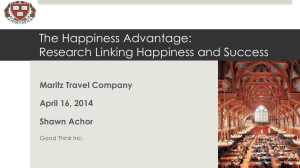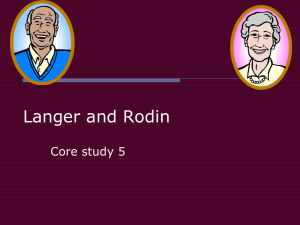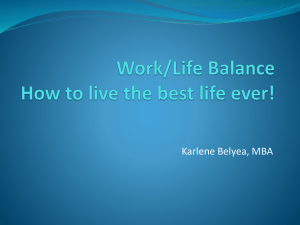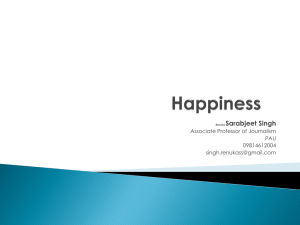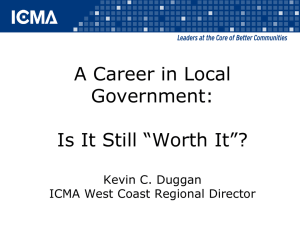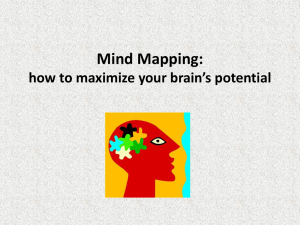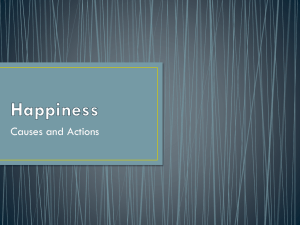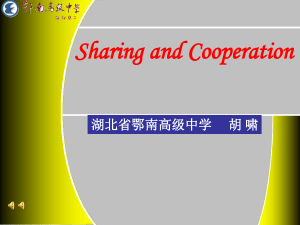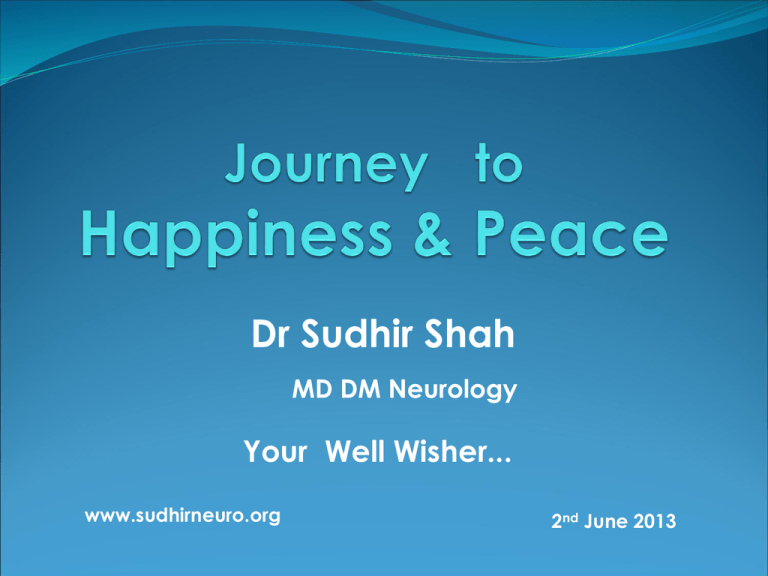
Dr Sudhir Shah
MD DM Neurology
Your Well Wisher...
www.sudhirneuro.org
2nd June 2013
2
3
Purpose of life
Everybody wants to live
Everyone wants to be happy ( nobody wants
unhappiness )
Everyone wants peace ( nobody wants
otherwise )
Ultimate purpose of life is to enjoy and live
happily and make others happy…
4
Disclaimer
Nobody is perfect and all of us are students
Easy to Preach, but not very difficult to Practice
Happiness is not really hypothetical
Definition of Happiness varies from person to person
Also it is dynamic in the same person usually
It is journey rather than destination
But it is the dialogue we have to initiate now...
5
Plan of my talk
Defining Happiness
Psychology of Happiness
Neuroscience of Happiness
Measuring Happiness
How to be Happy
Philosophical and Spiritual perspective
6
Happiness Defined
Aristotle put it, “Happiness is
the meaning and purpose of
life, the whole aim and the end
of human existence”!
7
Happiness Redefined
Happiness is:
A pleasant feeling
A positive evaluation or
judgment
A favorable explanation
after the fact
An optimistic expectation
A sense of inner peace
A sense of connectedness
A spiritual experience
8
Psychology and
Evolutionary History
The Triune Brain
9
But to Cope with Urgent Needs,
We Leave Home . . .
Avoid: When we feel threatened or harmed
Leads to Anxiety disorders; PTSD; panic, terror;
rage; violence → leads to insecurity & pessimism
Approach: When we can’t attain important goals
Leads to Addiction; over-drinking, -eating, -gambling; compulsion;
hoarding; driving for goals at great cost→ Frustration &
disappointment
Attach: When we feel isolated, disconnected, unseen,
unappreciated, unloved
Leads to Borderline, narcissistic, antisocial PD;
symbiosis; folie a deux; “looking for love in all the
wrong places” → Rejection, unloved
This is the brain in its reactive mode of functioning
- a kind of inner homelessness
10
Three Levels of
Happiness
Three levels of happiness : pleasure, joy and bliss
All people fall into one of three groups... those who
are spiritually awake, those who are asleep and
those who are somewhere in the middle.
Your own personal definition of happiness will
depend on which of these groups you belong to
11
Pleasure
For those who are largely asleep
Happiness is sought from outer world and is
characterized by pleasure
Sensual, instinctual and physiological
Always perpetual and demand for more and more.
Leads to inevitable pain
ANIMAL INSTINCT
12
Where they find pleasure
Food
Sex
Places
Listening Music
Fragrance
13
What does it do for you?
14
fMRI during visual imagery
15
16
Physical Pleasure and the Ventral
Striatum
When people experience physical pleasure, the
ventral striatum is activated (George, 1995)
17
Chemicals of Pleasure
18
NORMAL
SEROTONIN
CATECHOLAMINE
DOPAMINE
DEFICIENT
you’re positive,
confident, flexible,
and easy going
Become negative,
obsessive, worried
irritable, and sleepless
you’re energized,
upbeat, and alert
you can sink into a
flat, lethargic mood
You’re more
talkative and
excitable. It affects
brain processes
ability to experience
pleasure and pain
Have depression,
chronic boredom, loss
of satisfaction, chronic
fatigue, mood swings
and poor attention
19
Joy
Begin to feel happy for no particular reason
Comes from inner world (self)
More psychological
Refined Desires
Through service to mankind, success, achievements
& spiritual practices like prayer, chanting , religious
reading and satsang
JOY is HUMAN
20
Achievement
21
Engagement
22
Meaning
23
Spiritual practices
24
Abstract perception of joy
25
Neural circuitry of Joy
26
Chemicals of Joy
NORMAL
OXYTOCIN
VASOPRESSIN
Good social
recognition, calm
and relaxed mood,
ego faculty
Good social
Recognition, Prompt
responsive , attentive
for stressful situations
DEFICIENCY
Become negative,
depressed , socially
withdrawn , anxious
Socially withdrawn,
feel overwhelmed in
stressful situations
27
Bliss
The highest state
Here mind and all its activity ceases
Our consciousness becomes identified with universal
consciousness
Experience of just being
Permanent meditative state
Fully awake
PIOUS PERSONS
28
Inner Peace
Inner Peace refers to a state of being “mentally” and
“spiritually” at peace, with enough knowledge and
understanding to keep oneself strong in the face of
discord or stress.
Peace
of mind is generally associated
happiness, bliss and contentment
with
29
Mindfulness Practice
Observing
the
body
and
mind
intentionally
Letting experiences unfold from moment to moment and
accepting them as they are
Observing
thoughts without getting caught up in them.
No effort to control anything except the focus and direction of the
attention. Not a passive process, yet does not involve trying to get
anywhere
Eating meditation, sitting meditation, working meditation and
meditation during each act is the goal of mindfulness practice
30
Meditation
Patanjal Dhyana
Anapan Sati
Smriti Upasthan
Vipashyana
Preksha Dhyana
Jain Dhyana
Spand Dhyana
Mantra Dhyana
Nabhi Dhyana
Swapna Dhyana
Nidra Dhyana
Yoga nidra, Nyas
Kriya Yoga
Mrutyu Dhyana
T.S Meditation
Kundalini
Kayotsarga
Tratak
Suryasamyam
Adarshdhyana (mirror)
Swaminarayan Dhyana
Arup Dhyana
Purnayoga Dhyana
Atit Dhyana (past)
Bhavidhyana (future)
Sarpalanchan Dhyana
Samarpana Dhyana
Tathata
Hoo-Dhyana (Dynamic
Meditation)
Sahaj Dhyana
Your own system
All methods are great
31
Vipashyana
Operation of the mind, by the mind
Calm and quiet mind
Awake and attentive mind
Equanimous mind
32
symbolic representation of the self
33
Neural Circuits of Meditation
34
Endorphins
35
+
Glutamate
Arcuate Nucleus of
Hypothalamus
Prefrontal cortex
Activation by Meditation
+
Endorphins
+
Experience of Well being
36
37
+
Glutamate
Reticular nucleus of Thalamus
Prefrontal cortex
Activation by Meditation
+
GABA
+
Experience of just being
Inhibition of Superior
38
Parietal lobe
The process of meditation apparently increases activation in
the prefrontal cortex and stimulates the reticular nucleus of
the
thalamus,
leading
to
release
of
inhibitory
neurotransmitter GABA. GABA have a central role in cortical
inhibition and Cortical Silent Period, modulating cortical
excitability and neural plasticity
39
Blissful chemicals
NORMAL
ENDORPHINS
GABA
DEFICIENT
you’re full of cozy
feelings of comfort,
pleasure, and
euphoria.
you may be crying
during commercials
and overly sensitive to
hurt.
you’re relaxed and
stress-free.
you’ll be wired,
stressed, and
overwhelmed
40
So, in conclusion Pleasure is dependent on others,
joy less so and bliss is completely independent of
anything
Pleasure is animal, joy is human and bliss is next to
Divine
41
Three levels of Happiness
BLISS
Happiness
JOY
Being part of something
bigger than yourself
GABA, Endorphins
Happiness within
Oxytocin, Vasopressin, Dopamine
PLEASURE
Worldly things
Serotonin, Dopamine , Catachoalmines
Time and knowledge
42
Instruments Used in the Study of
the Brain and Happiness
Can we really measure happiness, and how?
Who would know better than
Neurologists and psychologists?
43
Neuropsychological testing
(three level questions )
How are you feeling right now (from 1 to 7)?
1)
Introspection
All things considered, how happy are you these
days (from 1 to 7)?
2)
Introspection, comparative judgement
On the whole, how good do you think your life is
(from 1 to 7)?
3)
Introspection, comparative judgement, relative to
conception of ‘the good life’
44
Happiness ‘Continuum’
Level 1
- Momentary
feelings
- Mood
- Pleasures
- Not suffering
Level 2
Level 3
- Judgements
about
feelings
- Net level 1
happiness
- Well-being
- satisfaction
- Holistic
evaluation of
value of life
- Flourishing
- Needn’t
include
pleasures
More emotional, sensual, and reliable
More cognitive, moral, and easily biased
45
Electroencephalogram (EEG)
46
Magnetic Resonance Imaging (MRI)
Magnetic
Resonance Imaging
(MRI) uses changes
in
electrically
charged molecules
when
they
are
place
in
a
magnetic field to
assess differences
in cerebral activity
in different regions
of the brain
47
Functional Magnetic Resonance
Imaging (fMRI)
• Functional
Magnetic
Resonance Imaging
(fMRI) tracks the
brain’s blood flow
and oxygen use two measures of
neuron activity
• fMRI is useful to find
out
emotional
processing
in
particular areas of
brain
48
Positron Emission Tomography
(PET)
Positron
Emission
Tomography
(PET)
scans are good for
showing the many
brain structures that
may be involved in
a
functions
like
pleasure and help to
examine
the
processing
of
neurotransmitters
49
The Brain and Happiness
Different components
of
happiness
are
found
in
different
areas of the brain.
That
is,
happiness
does not seem to
have
a
clearly
defined
neurobiological home
50
Happiness and the Pre-frontal
Cortex
Laughter
responses
are
generated in the prefrontal
cortex. (George, 1995)
Pleasant film clips, pleasant
tastes,
&cash
incentives
increase left pre-frontal cortex
activity
Unpleasant
film
clips,
unpleasant tastes, and a threat
of cash loss raise activity in the
right pre-frontal cortex
51
Happiness, the Rostral Anterior
Cingulate Cortex and the Amygdala
When people think about good events the rostral anterior
cingulate cortex (rACC) and the amygdala are activated.
However, the correlation with optimism was biggest with
the cingulate cortex (Phelps & Sharot, 2007)
52
Happiness and the Temporal and
Parietal Lobes
When people feel
happy, the
characteristic pattern
shows a decrease of
activity in the brain
that are committed
to forethought and
planning—the
temporal and
parietal lobe
(George, 1995)
53
Who is more Happy?
Young, middle-aged, or old?
Married or Single?
Men or Women?
Spirituality?
Rich vs. Poor?
54
Geography of Happiness
Green = Happiest > Blue > Purple > Orange > Red = Least Happy; Grey = Data
not available
55
Percent
100
Age group
80
60
40
20
0
15- 24
25- 34
35- 44
45- 54
55- 64
65+
AGE-WISE: % “Satisfied” or “Very
Satisfied” with Life as a Whole
56
Percent
100
Males
80
Females
60
40
20
0
Satisfied
Very happy
Pooled data from 169,776 interviews.
Gender and Well-Being in
Sixteen Nations
57
45
Percent Very Happy
40
35
Married
30
25
Never married
Separated
20
Divorced
15
10
5
0
Men
Women
58
Percent “very
happy”
100
Spiritual commitment
80
60
40
20
0
Low
High
Spirituality and Happiness
59
45
41
40
35
29
30
25
23
20
15
10
5
0
Not Close/Not Believe
Somewhat Close
Extremely Close
65 % Very Happy and Felt Closeness to
God
(n = 9896, NORC, 1983-1991)
60
Money and happiness
Money produces shortterm benefits;
More money will not
raise well-being
61
Does money buy Happiness?
62
63
Money and happiness
Money can bring security as well as comfort &
pleasure
It can bring improved standard of living and
education
But
Money corrupts , success corrupts
They take away morality, relationships, health,
bliss and peace
64
Understanding happiness
Happiness is not something that happens, that
money or power can command
It is only by controlling our inner experience that we
can become happy
Happiness cannot be reached by consciously
searching for it
65
Road to Success
Money
Fame
Achievements
Awards
Possessions
Road to Joy, Bliss
and Peace
Godhoodness
Spirituality
Philosophy
Morality
Religion
66
What do you remember?
Applause dies away!
Trophies gather dust!
Winners are soon forgotten
But you remember ,the ones who take care of you &
appreciate you
67
“PHYSICIAN
HEAL
THYSELF”
68
Why Doctors are not
happy
Professional carrier
Money , fame
Teaching
Time management
Academics
Traffic , mobile
Research
Staff management
Administration
Misunderstandings
Family life
Legal issues
Children issues
Paper work
Interpersonal relationships
Demanding patients
Competition
Caregivers stress
Negative emotions like ego
Physical and Mental
jealousy
HEALTH
69
Determinants of
Happiness
70
Gene therapy
VMAT :
Vesicular Mono Amine Transporter gene
on chromosome 10q25
Produces the sensations of mystic experiences,
including the presence of God and spirituality as a
state of mind
MAOA :
Monoamine oxidase A on X chromosome
Low-expression is associated with higher selfreported happiness in women
71
Determinants of
Happiness
72
To control your circumstances
1. Reduce your commitments
2. Reduce your interactions with persons
sanjog mula jiven pattaa dukha parmpara...
The more you have contacts with persons and
situations, the more will be your unhappiness
( cascade of problems )
Lord Mahavir
73
How to enjoy journey of life ?
Key to Happiness
Physical
Moral
Mental
Religious
Spiritual
74
Happiness And Peace :
A Physical perspective
pahelu sukh te jate narya
Eat right
Exercise
Get enough sleep
Good excretory functions (biju sukh?!)
Learn to relax
Laugh exhaustingly
Love abundantly
75
GET ENOUGH SLEEP
76
Nix Coffee?
77
WALKING
78
RESISTANCE TRAINING
79
VENTING
80
Massage
81
YOGA
82
Laugh frequently
Laugh frequently
At yourself and not others
Laugh from the core of your spirit not in artificial
ways
Learn to laugh out in all mistakes and bad situations
83
Smile!
Smiling is the main way to tell if someone’s
happy… but only if they are real smiles
Smile solves many problems
84
Silence!
Silence avoids so many problems
85
Love abundantly
86
The Rewards of Love
87
Helping Others
88
Dopamine
Serotonin
Oxytocin
Endorphin
Exercise, Food & Mood (Happy Chemicals)
89
Dopamine
The omega-3 fatty acids are proven to create
dopamine. Kauncha like seeds also.
Useful sources of building blocks for dopamine:
Apples
Beet
Cucumber
Green leafy vegetables
Honey
Cheese
Sweet peppers
Watermelon
90
Serotonin
To create serotonin eat low
sugar carbohydrates such as
fruits and vegetables
Bananas
are
especially
powerful serotonin inducers
and bring on an immediate
calming effect because of
the complex B vitamins they
have
Try some light stretching or
breathing exercises along
with some soothing music to
complete the mood.
91
Oxytocin
Eating
comfort foods:
Eating your favorite
food such as chocolate,
ice-cream or any meal
that you really enjoy will
release oxytocin
92
How Chocolate
Could Influence
Brain and
Behavior
93
Endorphin
Complex carbs like pasta,
breads, and foods with
natural glucose, like grapes
make the perfect mixture for
creating endorphins
Eating spicy food like hot
chili pepper
A routine of aerobic activity:
brisk walking, biking,
swimming or massage
or
94
Medical management
If happiness has a biological cause in the brain,
then we will be able to influence it with drugs,
surgery, bionics etc… but should we?
If our brains show equal ‘happiness activity’, then
are we equally happy? How can we know this?
95
Psychological counselling
96
Mood elevators
97
Future of Happiness
98
The God Gene
99
Building on Strengths
Key to Engagement and Meaning
Gratification and satisfaction
100
Six Virtues for Gratification
From the great philosophies and religions of the
world:
wisdom and knowledge
courage
love and humanity
justice
temperance
spirituality and transcendence
101
Six Areas of Strength
Wisdom &
Knowledge
Temperance
Courage, firmness
Transcendence
Love, warmth
Leadership ,Justice
102
KNOWLEDGE & WISDOM
1. Creativity
2. Curiosity
3. Love of learning
4. Wisdom / perspective
5. Open-mindedness
COURAGE & FIRMNESS
6. Bravery
7. Persistence
8. Integrity
9. Vitality
HUMANITY & LOVE
10. Give & receive love
11. Kindness
12. Social intelligence
LEADERSHIP & JUSTICE
13. Citizenship
14. Fairness
15. Leadership
TEMPERANCE
16. Forgiveness / mercy
17. Modesty / humility
18. Prudence
19. Self-regulation
TRANSCENDENCE / SPIRITUAL
20. Appreciation of excellence and
beauty
21. Gratitude
22. Hope
23. Humor
24 Spirituality
103
3 “C’s” of Happiness
Control
Challenge
Commitment
104
*Challenge*
Openness
To New Experiences
Expanding
Social
Support
Network
105
Self
Awareness
and
Reflection
*Commitment*
106
Self Discipline
and
Self
*Control*
107
Happiness and friendship
A person doesn’t
need a large
number of friends
to be happy – he
needs one the
best
friend
108
Learning from Children
Spend time with children. Learn more about
laughter, spontaneity, curiosity, acceptance,
resilience, trust, determination, and your
imagination
They are here to teach us!
109
Happiness for children
By giving them
Your Time
Education and knowledge
Culture and attitude
Wisdom and art
110
How to enjoy journey of life ?
Key to Happiness
Physical
Moral
Mental
Religious
Philosophical
Spiritual
111
Happiness : religious, philosophical
and spiritual key
112
Address of Happiness
At
some stage you realize
happiness are not outside
that
peace
and
The root cause of miseries : thoughts, desires,
emotions , ego, attitude , mind wondering between
past & future, raga and dwesha ( anger, greed,
deceit and passion) …etc all functions of mind
113
Thoughts...
We are what we think
All that we are arises with our thoughts
With our thoughts we make the world
Speak or act with an impure mind and trouble will
follow you, as the wheel follows the ox that draws
the cart
Your worst enemy cannot harm you as much as your
own thoughts, unguarded
114
Attitude
Attitude is a little thing that makes a big
difference
115
Attitude
“ The Longer I live, the more I realize the impact of attitude on life. Attitude
to me, is more important than facts. It is more important than the past, than
education, successes, than what other people think or say or do. It is more
important than appearance, giftedness or skill. It will make or break a
company…….. a church…. a home. The remarkable thing is we have a
choice every day regarding the attitude we will embrace for that day. We
can not change our past..... we cannot change the fact that people will act
in a certain way. We cannot change the inevitable. The only thing we can
do is to play on the only string we have, and that is our attitude……. I am
convinced that life is 10% what happens to me and 90% how I react to it.
And so it is with you….. We are in charge of our Attitudes ”.
- Charles Swindoll
116
Forgiveness
REACH (Everett Worthington)
Recall the hurt
Empathize with the perpetrator
Altruistic gift of forgiveness
Certify you forgive
Hold on to the forgiveness
Use wisdom and discretion:
Typically you do NOT tell the perpetrator that you have
forgiven him/her
GHALIB…..hum ne jindgi ko aasan kar diya…..
117
Interpersonal relationships
1. Altruism & Friendship ( Maitri)
2. Appreciation & Respect ( Pramod )
3. Equanimity & Guidance ( Madhyastha )
4. Forgiveness, Compassion & Prayers (Karunya )
118
Acceptance
“ God grant me the courage to
change the things I can, the serenity to
accept the things I cannot, and the
wisdom to know the difference.”
Cultivating an attitude of non-judgment
Acceptance is not resignation
It is a realization and appreciation of the inherent
imperfections of life
119
Buddhism on Happiness
There is no fire like desire. There is no weakness
like anger. There is no suffering like the
khandhas. There is no happiness greater than
peace (Dhammapada, 202 & 208)
120
Mathematics of happiness
Happiness
= 2 x happiness
2
Happiness
= Objects
Desires
Total units of Happiness remains same
121
Ambitions
Where Ambitions end, Happiness begins
Amount of balance in the bank at the time of
your death is the extra work that you have done,
which you should not have done
122
ichao rahi jaya Ane swas KhutiI jaya tene
Mrutyu kahevay,
ichao pauri thai jaya Ane swas rahi jaya
tene Moksha kahevay.
123
Vaishnavajan
Eyes : compassion and satisfaction
and not reflecting greed or jealousy ( lobha )
Words : forgiveness , appreciation and care
and not anger or criticism
( krodha)
Mind : equanimous and fair
and not having raga (attachment) or dwesha(disliking )
Emotions : calm and passionless
and not having perversions or aspirations ( kama )
Nature : gentle , humble and reliable
and not fraudulent or hippocrate ( maya )
Behaviour : Loveful and kind
and not hatred or discard
124
Religion Opens
Doors of Happiness
Religion confers upon man eternal life and guides
his footsteps in the world of morality
It opens the doors of unending happiness and
bestows everlasting honor upon the human kingdom
It has been the basis of all civilization and progress
in the history of mankind
125
Ethics
126
Spiritual reading
Philosophy of Karma
127
Satsang
128
Chanting
129
Prayer : four steps...
130
Comparison of Baseline to Prayer :
Limbic inhibition
Baseline Scan
LIMBIC
Prayer Scan
LIMBIC
131
Ratnatrayi
Righteous knowledge
Righteous perspective
Righteous conduct
Lead to eternal happiness
132
PATANJAL RAJ YOGA
Yama
:
Nonviolence, truth, non-stealing
celibacy and aparigriha
(Non-collectiveness)
Niyama
:
Purity, Penance (Austerity)
Satisfaction
Spiritual learning
Worship & dedication
Asana
:
Pranayama
:
Pratyaahar
:
Dharna
:
Dhyana
:
Samadhi
:
133
T.S.MEDITATION
134
SPECT Images at Baseline and
During Meditation
Prefrontal Cortex
Baseline
Prefrontal Cortex
Meditation
135
SPECT Images at Baseline and
During Meditation
Baseline
Meditation
Superior
Parietal Lobe
Superior
Parietal Lobe
136
Christian Nuns, Recalling
Profound Spiritual Experiences
Beauregard, et al., Neuroscience Letters, 9/25/06
137
Lazar, et al. 2005.
Meditation
experience is
associated
with increased
cortical thickness.
Neuroreport, 16,
1893-1897.
138
Set Peace of mind and Happiness, your highest
goal and organize your life around it
Ask yourself before each thought, action and
speech… whether this will bring happiness and
peace
139
12 Secrets of Happiness
Accept What You Have : NOBODY GETS MORE OR BEFORE
Enjoy What You Do and without expectations
Live For Today and in this present moment
Choose Happiness
Improve Relationships… Always appreciate, never criticize
Don't Compare, but Be Yourself
Preserve health and monitor it
Stop Worrying : THIS WILL ALSO GO AWAY
Get Organized and financial management
Think Positive
Moral values : DO ONLY THOSE THINGS TO OTHERS, WHICH…
Spiritual practices
140
Address of Happiness
1, Spiritual mansion ,
Meditation hall ,
Self realization lane,
Philosophy society,
Charity chowk,
Morality area ,
PIN : 000000
Religion station
141
Happiness is inside you
142
So Remember...
Its not easy to find happiness in ourselves, and it
is not possible to find it elsewhere
The road to success is different from highway to
peace, bliss and longevity
143
144
145
Great Books
Holy vedas, jain aagam, tripitak, patanjal yog sutra, sukh sadhak vidya
Austin, J. 2009. Selfless Insight. MIT Press.
Begley. S. 2007. Train Your Mind, Change Your Brain. Ballantine.
Carter, C. 2010. Raising Happiness. Ballantine.
Hanson, R. (with R. Mendius). 2009. Buddha’s Brain: The Practical
Neuroscience of Happiness, Love, and Wisdom. New Harbinger.
Johnson, S. 2005. Mind Wide Open. Scribner.
Keltner, D. 2009. Born to Be Good. Norton.
Kornfield, J. 2009. The Wise Heart. Bantam.
LeDoux, J. 2003. Synaptic Self. Penguin.
Linden, D. 2008. The Accidental Mind. Belknap.
Sapolsky, R. 2004. Why Zebras Don’t Get Ulcers. Holt.
Siegel, D. 2007. The Mindful Brain. Norton.
Thompson, E. 2007. Mind in Life. Belknap.
146
Key Papers - 1
Guglietti CL et al, Meditation-Related Increases in GABAB Modulated Cortical
Inhibition, BRAIN STIMULATION,Volume 6, Issue 3 , Pages 397-402, May 2013
Atmanspacher, H. & Graben, P. 2007. Contextual emergence of mental states
from neurodynamics. Chaos & Complexity Letters, 2:151-168.
Baumeister, R., Bratlavsky, E., Finkenauer, C. & Vohs, K. 2001. Bad is stronger
than good. Review of General Psychology, 5:323-370.
Braver, T. & Cohen, J. 2000. On the control of control: The role of dopamine in
regulating prefrontal function and working memory; in Control of Cognitive
Processes: Attention and Performance XVIII. Monsel, S. & Driver, J. (eds.). MIT
Press.
Carter, O.L., Callistemon, C., Ungerer, Y., Liu, G.B., & Pettigrew, J.D. 2005.
Meditation skills of Buddhist monks yield clues to brain's regulation of attention.
147
Current Biology. 15:412-413.
Key Papers - 2
Davidson, R.J. 2004. Well-being and affective style: neural substrates and
biobehavioural correlates. Philosophical Transactions of the Royal Society.
359:1395-1411.
Farb, N.A.S., Segal, Z.V., Mayberg, H., Bean, J., McKeon, D., Fatima, Z., and
Anderson, A.K. 2007. Attending to the present: Mindfulness meditation reveals
distinct neural modes of self-reflection. SCAN, 2, 313-322.
Gillihan, S.J. & Farah, M.J. 2005. Is self special? A critical review of evidence
from experimental psychology and cognitive neuroscience. Psychological
Bulletin, 131:76-97.
Hagmann, P., Cammoun, L., Gigandet, X., Meuli, R., Honey, C.J., Wedeen, V.J.,
& Sporns, O. 2008. Mapping the structural core of human cerebral cortex. PLoS
Biology. 6:1479-1493.
Hanson, R. 2008. Seven facts about the brain that incline the mind to joy. In
Measuring the immeasurable: The scientific case for spirituality. Sounds True.
148
Key Papers - 3
Lazar, S., Kerr, C., Wasserman, R., Gray, J., Greve, D., Treadway, M., McGarvey,
M., Quinn, B., Dusek, J., Benson, H., Rauch, S., Moore, C., & Fischl, B. 2005.
Meditation experience is associated with increased cortical thickness.
Neuroreport. 16:1893-1897.
Lewis, M.D. & Todd, R.M. 2007. The self-regulating brain: Cortical-subcortical
feedback and the development of intelligent action. Cognitive Development,
22:406-430.
Lieberman, M.D. & Eisenberger, N.I. 2009. Pains and pleasures of social life.
Science. 323:890-891.
Lutz, A., Greischar, L., Rawlings, N., Ricard, M. and Davidson, R. 2004. Long-term
meditators self-induce high-amplitude gamma synchrony during mental
practice. PNAS. 101:16369-16373.
Lutz, A., Slager, H.A., Dunne, J.D., & Davidson, R. J. 2008. Attention regulation
and monitoring in meditation. Trends in Cognitive Sciences. 12:163-169.
149
Key Papers - 4
Rozin, P. & Royzman, E.B. 2001. Negativity bias, negativity dominance, and
contagion. Personality and Social Psychology Review, 5:296-320.
Takahashi, H., Kato, M., Matsuura, M., Mobbs, D., Suhara, T., & Okubo, Y. 2009.
When your gain is my pain and your pain is my gain: Neural correlates of envy
and schadenfreude. Science, 323:937-939.
Tang, Y.-Y., Ma, Y., Wang, J., Fan, Y., Feng, S., Lu, Q., Yu, Q., Sui, D., Rothbart,
M.K., Fan, M., & Posner, M. 2007. Short-term meditation training improves
attention and self-regulation. PNAS, 104:17152-17156.
Thompson, E. & Varela F.J. 2001. Radical embodiment: Neural dynamics and
consciousness. Trends in Cognitive Sciences, 5:418-425.
Walsh, R. & Shapiro, S. L. 2006. The meeting of meditative disciplines and
Western psychology: A mutually enriching dialogue. American Psychologist,
61:227-239.
150
Gratitude
Dr. Shailesh Darji
Mr. Chintan Bavishi
Dr. Prakash Chauhan
Dr. Hansal Bhachech
Dr. Shehnaz Chinwala
Dr. Pratik Shashtri
Dr. Amit Bhatt
151

